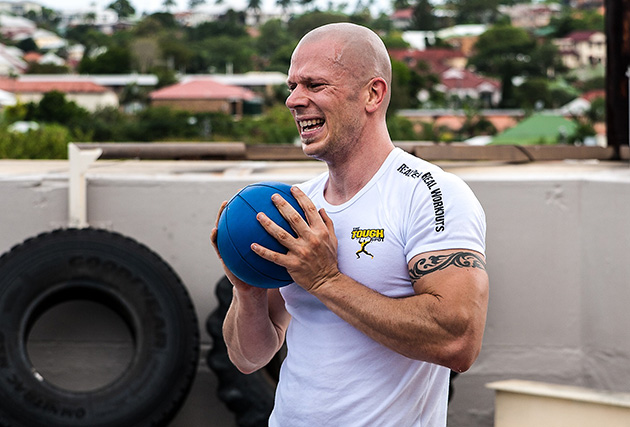The Kneeling Chest Launch Test involves throwing a Power Ball for maximum distance from a kneeling position, as a measure of upper body strength and power. This test is one of the tests of the SPARQ rating system for ice hockey and newly added to the football SPARQ testing (it replaced the maximum bench press), and their protocol is listed here.
purpose: This test measures upper body coordination, strength and power.
equipment required: 2 or 3 kg power ball, tape measure, foam pad for kneeling, clear open area for testing.
pre-test: Explain the test procedures to the subject. Perform screening of health risks and obtain informed consent. Prepare forms and record basic information such as age, height, body weight, gender and test conditions. Check the weight of the ball. The start line should be clearly marked. Perform a standard warm-up. See more details of pre-test procedures.
weights: males use 3 kg, females 2 kg, and all youth the 2 kg power ball.
 powerball throw test
powerball throw testprocedure: The athlete starts in a kneeling position with the back erect and facing the direction they are going to throw. The thighs should be parallel and the knees at the start line. Ensure that the toes are pointed backwards, as curled up toes can be used for greater traction. Starting with the ball grasped with both hands at the sides, and held out and above the head. The ball is brought down to the chest as their hips are brought back to the heels, then in one motion the ball is pushed forward and up (optimally between 30-45 degrees). A practice trial is allowed to learn the correct movements and get the best trajectory for maximum distance. They must not throw favoring one arm or rotate about the spine. The athlete is permitted to fall forwards over the line after the ball is released. The knees are not to leave the ground. Two attempts are allowed, with at least 45 seconds recovery between each throw.
scoring: The measurement is recorded in feet and inches to the nearest inch, measuring from the outer edge of the launch line to the central point where the Power Ball first lands. The best result of two throws is recorded.
results: US Decathlete Bryan Clay achieved 38 ft 9 in this test during a SPARQ testing exercise (published in SPARQ Magazine, Summer 2008).
target population: football, and other sports in which upper body power is important.
advantages: this test is easy and quick to perform for an individual, with the equipment required relatively cheap.
disadvantages: several people are needed to conduct this test smoothly: one to mark results, another to check technique and another to collect and return the balls. If testing a large group of participants, it can be time consuming to put all of them through this test.
comments: The angle the ball is thrown is important. You may want to explain to the subject about the optimal angle for maximal distance, and to allow some practice attempts.
The Test in Action
- This test is one of the tests of the SPARQ rating system for ice hockey and newly added to the football SPARQ testing protocol.
Similar Tests
- Seated Medicine Ball Throw
- Kneeling basketball throw test — a one-handed throw for distance from the kneeling position.
- Basketball Throw — two-handed push power with the back against a wall
- The "Seated Power Throw" test, part of the US Army Occupational Physical Assessment Test, uses a 4.4 pound (2 kg) medicine ball.
- Bench Press Max Power
Related Pages
- Medicine and Power Ball Fitness Tests
- About Medicine/Power Balls
- The SPARQ rating system for football and ice hockey
- SPARQ fitness rating system
- Other speed and power tests
- Medicine balls for sale


 Current Events
Current Events